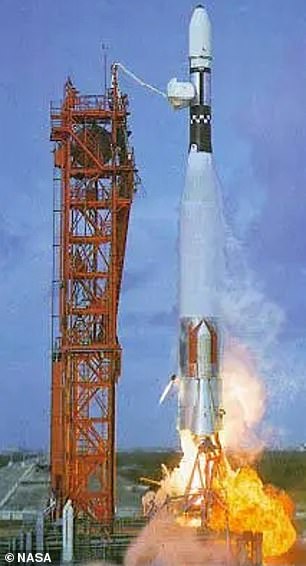The photos that shattered NASA's hopes of life on Mars: First ever images of the Red Planet snapped 59 years ago revealed a barren planet - squashing the belief it was a haven for aliens
- On July 15 1965, Mariner 4 was first craft to take close photos of another planet
- The images revealed a barren planet and squashed beliefs of alien life on Mars
With their jagged grooves and round dimples, these grainy grey images could be mistaken for the surface of the moon.
But they actually show a much more distant member of our solar system – Mars.
They were snapped by NASA's Mariner 4 plucky spacecraft on July 15, 1965, to reveal more about our rusty red planetary neighbour.
Until then, telescopic images of Mars – namely enigmatic dark patches on its surface – triggered the belief that it was home to an alien civilization.
But Mariner 4 revealed a barren planet, squashing the belief it was a haven for life.

After an eight-month voyage to Mars, Mariner 4 made the first flyby of Mars, becoming the first spacecraft to take close-up photographs of another planet

A television camera onboard takes 22 pictures, covering about 1 per cent of the planet. Initially stored on a 4-track tape recorder, these pictures take four days to transmit back to Earth
Daniel Bayliss, an assistant professor at the University of Warwick's department of physics, called Mariner 4's legacy 'immense'.
'Mariner 4’s main mission was to take the first close-up images of Mars, which would tell us if it was a world that might harbour life,' he told MailOnline.
'However it showed Mars to be a heavily crated and most likely lifeless.'
Mars was always known about by humans because it's visible in the night's sky with the naked eye – a bright dot with a distinctly reddish-orange tint.
But the first person to see Mars through a telescope was the legendary Italian astronomer Galileo Galilei, in 1610.
From then until as recently as the 1950s – the golden age of Mars-inspired sci-fi books and comics – it was reasonable to think that Mars had life on its surface.
Dark markings on the Martian surface were perceived to be vegetation or 'canals', triggering the belief that the planet was a lush world like Earth.
At the time, scientists thought the vegetation was a sign that an advanced human-like civilization lived on Mars.
In the 1956 book 'Guide to Mars', British astronomer Patrick Moore wrote: 'There is no reason to suppose that low forms of vegetation may not exist on Mars, whilst there is a great deal of evidence that they do.'
To learn more about the inner solar system – Mars, Venus and Mercury – NASA launched the $554 million Mariner programme in 1962.

Pictured, the best Earth-based telescopic image of Mars prior to Mariner 4’s mission, captured by the 100-inch Mt. Wilson Observatory in 1956. Note the enigmatic dark patches on the surface

All Mariner spacecraft were based on a hexagonal or octagonal bus, which housed all of the electronics, and to which all components were attached

A 1962 map of Mars, showing 'canals' snaking through the Martian landscape. The existence of the canals was debated as no close-up pictures of Mars had been taken - until Mariner 4's flyby in 1965
Mariner 1 and 2 had Venus as their target, while Mariner 3 in November 1964 turned attentions towards Mars – although it suffered an unfortunate launch failure.
Thankfully, Mariner 4 – launched just a few weeks later from Florida's Cape Canaveral – was more successful.
Mariner 4 spent 228 days travelling the 325 million miles, finally getting close enough to snap photos on July 14 and July 15, 1965.
At its closest, on July 15, it was 6,118 miles (9,846km) away from the planet.
An on-board camera took 22 pictures, covering about 1 per cent of the Martian surface, which were stored on a 4-track tape recorder and took four days to transmit back to Earth.
But to NASA's disappointment, instead of evidence of a lush world, photos revealed a dead surface dimpled with craters, resembling the moon more than Earth.
Dr Bruce Betts, chief scientist at the Planetary Society, said the craft proved that the Martian environment 'was very hostile to life as we know it'.
He told MailOnline: 'It found cold temperatures, a thin atmosphere, and no magnetic field, which showed that, unlike Earth, the surface would be susceptible to harmful radiation.'

'The invasion begins!' The belief that Mars could harbor alien life fueled some sci-fi classics, including the trading card series Mars Attacks (1962)

Mars is the fourth planet from the sun - a dusty, cold, desert world with a thin atmosphere. Pictured, Mars captured by the Hubble telescope

Launch of Mariner 4 from Florida's Cape Canaveral, November 28, 1964
NASA said Mariner 4 imaged some of the oldest and most heavily cratered terrain on Mars, while missing 'more diverse and geologically more recent features'.
'All in all, these findings dashed many scientists’ expectations of Mars as a place hospitable to life,' it said.
According to Professor Bayliss, 'no-one knew' what life, if any, NASA scientists were expecting to find there, but it may not have been a huge surprise to find 'a barren Mars'.
'But it certainly did answer an age-old question as to what the surface of Mars was really like,' he told MailOnline.
Ever since, scientists switched their focus to find evidence of past life on Mars, or basic organisms that are hidden from the view of any spacecraft.
Dr Betts added: 'Mariner 4 demonstrated if there was life, it would likely be in the form of microbes that might be able to survive the extreme environment.'
To date, no proof of past or present life on Mars exists, but scientists are in agreement that liquid water was once abundant there, perhaps as recently as 2 billion years ago, before its atmosphere was lost and the liquid water evaporated.
Speaking to MailOnline in 2022, Professor Brian Cox said that the most advanced life to ever have existed on Mars was likely single-celled organisms 'at best'.
Of course, since the 1960s, spacecraft have repeatedly landed safety on the Martian surface and taken brilliantly clear images of the dusty ground.
But in an era that relied on rotary dial telephones, sending a little machine hundreds of millions of miles away to another planet was an unprecedented achievement.

This image taken by NASA's Curiosity Mars rover shows a close-up of the rippled textures on Mars
Professor Bayliss said Mariner 4 'broke new ground in terms of technology and exploration'.
'It paved the way for future space missions, and led to the development of many new technologies such as digital imaging and satellite communications,' he told MailOnline.
'These are things that we are all benefiting from now.'
After its voyage past Mars, Mariner 4 maintained intermittent communication with Earth and returned data about the Martian environment for two more years.
But by the end of 1967, the spacecraft had suffered tens of thousands of micrometeoroid impacts and was out of the nitrogen gas it used for maneuvering.
The Mariner 4 mission officially ended on December 21, 1967 – and it's believed what's left of craft is still orbiting around the sun, an obsolete bit of space junk.






































































































































































